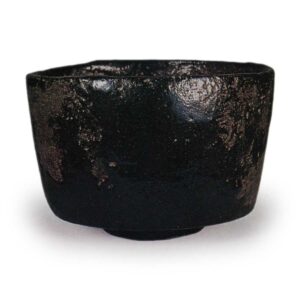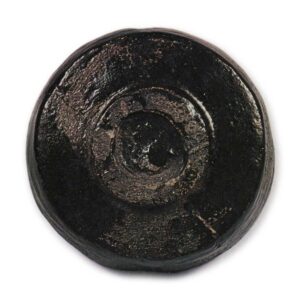

Height 8.6 cm, mouth diameter 12.2 cm, base diameter 5.2 cm
Goto Museum of Art
The author of “Koetsu” written in gold-painted characters on the front cover of the inner box is unknown. The ink inscription “Shichisato Koetsu” on the cover of the mulberry outer box is also by an unknown author. The inscription “Shichisato” is said to have come from the possession of a man named Shichisato Hikoemon, but the identity of Hikoemon is unknown. Later, it was handed down to Iseya Seizaemon, a fudazashi in Kuramae, Edo, and then to a certain person in Kanazawa, Masuda Katsunori, and Masuda Nunoo. After World War II, it was owned by some eccentric person in Kansai, and then it came into the possession of Keita Goto, and was transferred to the Goto Museum. It is a semi-tubular tea bowl with a ridge at the waist, similar to “Fujisan,” and it rises in a straight line while widening from the waist to the mouth. The base is rather small and round, and the tatami mats are flat, but the shaving inside the base shows Koetsu’s unique artistry, which is common to “Fujisan”, and the tatami mats are unevenly marked with five marks. As usual, the surface is almost flat with no tea stain, but the base seems to have been slightly pushed up during firing, and the center of the bowl is slightly raised. The mouth rim is flattened, but it is not as sharply made as the “Rain Clouds” and is more gentle in appearance.
The body is covered with a jet-black yuzu (Japanese citron) inside and out, and there are large areas of overglaze on the inside and outside of the body as well as on the rim, which have been fired to an iron-like finish, with a single crack running from the rim to the base of the bowl. According to “Taisho Meiki-kan”, a tea bowl called “Tekkabe”, which was burnt down and has not survived, seems to be of the same style.



